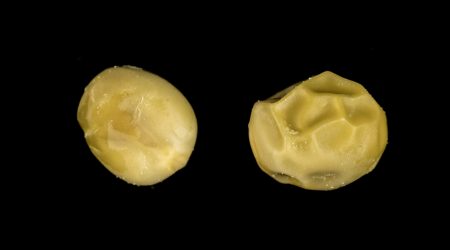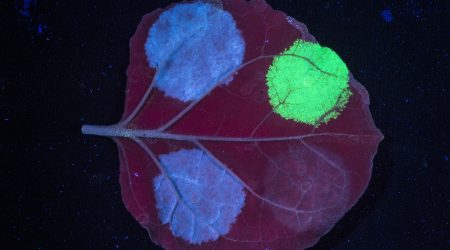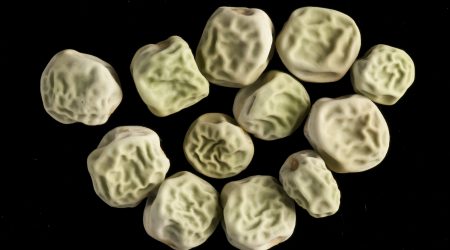To many people, peas are something that you push around a dinner plate or are a mushy extra to fish and chips
But times are changing for peas and pulses. For reasons of health, environment and economy, all the indications are that this is a crop destined for bigger things.
Professor Domoney, whose research aims to understand the genetics and biochemistry of the pulse crop, got a sense of the changing times recently when a taxi driver asked her what she did.
Domoney laughs.
“But I told him, and he said ‘Ah! You mean peas and lentils?’ He went on to tell me how he and his wife were very keen on cooking lentils, among other pulses, and that he was buying pea protein online for fitness and health. I checked out the website he mentioned, where indeed one can buy bags of pea protein advertised as providing a non-meat protein fix that can be mixed with other foods.”
The pea protein market is expanding, as evidenced by the availability of pea protein supplements, pea protein-enriched bread and a growing range of pea snacks. Pea protein-enriched bread provides up to a third fewer carbohydrates and additional protein. However, pea seeds are a source of much more than protein. They contain a range of vitamins, minerals and phytochemicals which are linked to health benefits and the presence of resistant starch in dried wrinkled peas could contribute to a major nutritional intervention in the prevention of Type-2 diabetes. So why is the pea overlooked when it offers so much?”
“It’s been around a long time which is maybe why it is not appreciated,” says Professor Domoney. “Also, lots of people lost touch with pulses over a period when meat became much more available rather than the luxury it once was. The use of dried pea, as with other pulses, were viewed as more of a poor man’s food.”
The history of pea genetics is entwined with the history of the John Innes Centre which was set up as the John Innes Horticultural Institution in 1909. First director William Bateson was fascinated with the early genetics experiments carried out by Gregor Mendel, whose famous experiments using pea plants helped him to uncover the basis of the inheritance of traits, using the term ‘factors’ to describe units of inheritance. Those experiments lay buried for 40 years before their re-discovery. Then Bateson and his colleagues ushered in a new era of genetic studies where they were able to study many traits.
“Today genetics is at the core of everything we do,” explains Professor Domoney. “To use genetics to understand traits, we need variation and for pea we get most variation through the John Innes Centre germplasm collection which was started in the days of the John Innes Horticultural Institution while it’s home was in Bayfordbury, Hertfordshire.”
The germplasm collection is the national resource for pea hosted at the John Innes Centre and available to scientists, farmers and food retailers. Over 3,500 lines of pea are curated on site, and these have been collected from many regions of the world representing a wide range of climatic and geographic conditions.
It was while screening 2,822 lines from the pea germplasm collection that Professor Domoney’s group made the exciting discovery of a “super-pea”. This exciting find is a wild pea from Turkey that does not produce protease inhibitors in its seeds, one type of so-called ‘anti-nutritional factors’ which reduce nutrient availability during digestion. Using modern genomic resources and related technologies such as speed breeding, Professor Domoney’s team hopes that the “super-pea” will be developed as a meat-free protein source and as a soybean replacement in animal feeds.
This and related work, plus a range of external factors, has led Professor Domoney to believe there are three reasons for prioritising pulse crops in 2019. The first of these is environmental. Legumes including peas fix their own nitrogen, naturally enriching the soil for other crops used in rotation. This means they are a potentially important means of reducing the use of fertilisers in modern agriculture.
Additional environmental benefits include replacing at least some of the soybean currently used as a source of protein in animal feeds, relieving the stress on environmentally sensitive regions which are used to growing this crop.
Secondly, economically there is cause for optimism. While the pulse crop is still a fraction of staples such as wheat, maize and rice, its popularity as a food source is increasing, explains Professor Domoney, “We are hearing of more and more demand from the industry for pea protein and other seed products. Many other pulses, for example kidney beans, need to be boiled extensively to inactivate the seed lectin. Pea seeds don’t have this type of lectin, so they are very amenable to uses within the food industry.”
And finally, for the health of the nation Professor Domoney explains;
Professor Domoney stresses the growing importance of the strong stakeholder group that she set up within the Pulse Crop Genetic Network (PCGIN). Five-year funding for PCGIN from Defra was announced in January 2018, underlining its importance to the UK’s agricultural and industrial strategy.
Commercial outcomes and impact have become more important to Professor Domoney’s personal approach to science as her career has developed. “When I started out as a researcher the emphasis was on fundamental molecular genetics and understanding of why seeds made the proteins they did,” she explains.
“I did not have any real expectation that one day the knowledge and resources might be useful. But the interactions with a wide range of stakeholders and the application of our discoveries has become much more important to my approach.”
It looks like 2019 will be a great year to celebrate the place of pea and pulses in history… and on the plate. The mighty pea is no longer being pushed around.





